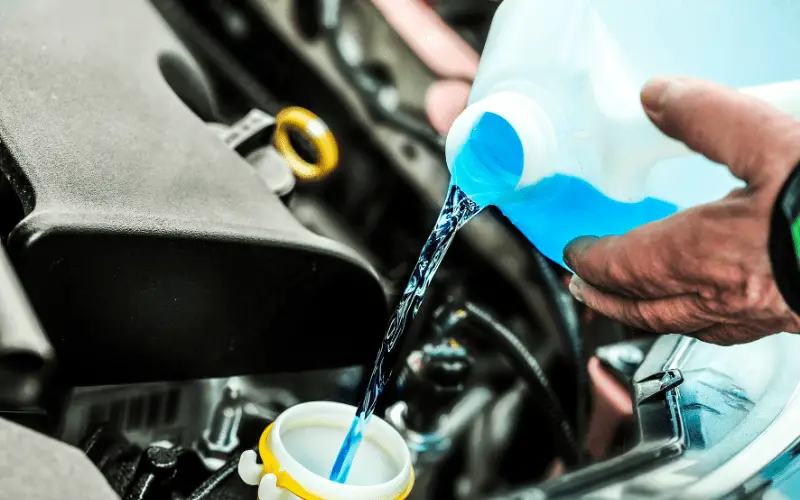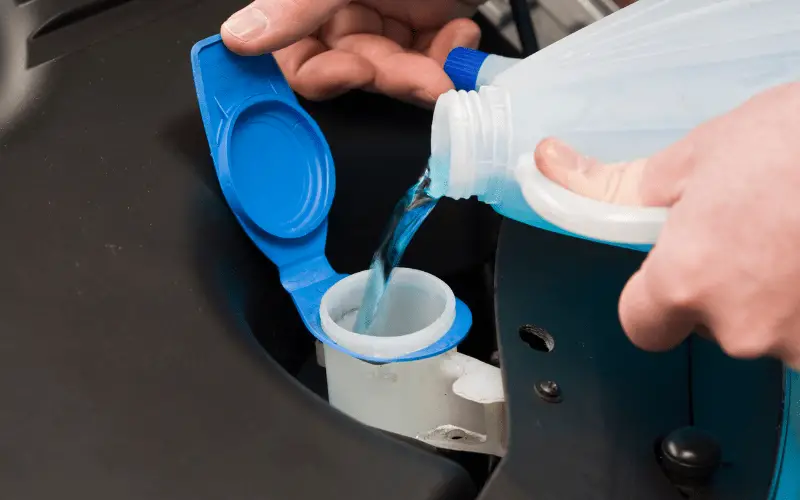Published Date: October 17, 2020
Last Updated on October 14, 2022 by
It is very important that you winterize your RV for the upcoming chilly days (winter is coming). Basically, there are RVs that are advertised as the best options for cold weather.
However, you still need to winterize such RVs to be on the safe side. One of the ways to prep your motorhome for winter is by purchasing RV antifreeze.
But the issue is how much RV antifreeze to put in holding tanks. There are different types of RV antifreeze you can put in holding tanks, and the quantity you should put rely on the size of your tank. Well, let’s explain this further with clearer points.
Table of Contents
What Type Of RV Antifreeze Should You Put In Holding Tanks?
Generally, RV antifreeze is non-toxic and different from other antifreeze, you know. What makes an antifreeze toxic or non-toxic is the formula used in its production.
Non-toxic RV antifreeze contains ethanol or propylene glycol as the primary components, and they are the best to use for your RV.
Simply put, you should only use non-toxic RV antifreeze when winterizing your RV. Usually, non-toxic RV antifreeze has a pink hue. The actual essence of using RV antifreeze is to keep your rig’s water tanks from freezing out due to extremely cold weather conditions.
So, now that you’ve pretty understood all of that, let’s see how much RV antifreeze you should put in holding tanks.
Quick note: most newer motorhomes and RVs feature heated and enclosed holding tanks. These types of tanks can withstand varying temperatures, as well as stand against freezing.
That said, if you own a luxurious RV, you practically should not worry about RV antifreeze formulas.
You Might Also Be Interested In: Learn How to Heat a Camper During Winter
How Much RV Antifreeze To Put In Holding Tanks?

You should put around 2 – 5 gallons of a non-toxic RV antifreeze into your holding tanks. The exact amount depends on the tanks’ sizes. However, before putting the RV antifreeze into your tanks, you need to drain them and blow out everything.
Adding RV antifreeze is part of winterizing a motorhome for cold weather. There are other winterization tips you need to know.
Winterizing Your RV for Cold Weather
First things first, you need to drain the tanks and the entire plumbing system. If water is stored in any of your RV’s plumbing systems, the extremely cold temperature during winter can cause it to freeze and expand. The plumbing system we are referring to includes the pipes, valves, faucets, and/or pumps.
How to Drain Your RV’s Plumbing System Using Compressed Air
- You need to get an air compressor and blow-out plug
- Disconnect the exterior water source and shut down all systems (turn off everything) in the RV. Check the RV’s user manual for a guide on how to turn off the refrigerator, washing machine, and other appliances that may be available.
- Open up the faucets and system drain valves to channel out all water
- Flush the toilets
- Now, connect the “blow-out plug” to a water inlet (not the freshwater tank).
- Set the air compressor to 30 psi or lesser pressure (don’t use the air compressor above 30 PSI to avoid damaging some systems).
- At this point, connect the air compressor’s hose to the blow-out plug and drain your RV.
- Ensure that your freshwater tank is completely emptied before closing the drain valves
- Now pour how much RV antifreeze you need to use into the gray and black tanks; you can also pump the antifreeze into the pipes.
How To Pump RV Antifreeze Into Your Rig
You need a hand pump to achieve this; if you’ve got one, follow the steps below:
- Drain the system (follow the steps explained above), but leave the water heater compartment.
- Connect the intake siphon on the hand pump to the RV antifreeze bottle, and the hose (from the hand pump) to the city water inlet.
- Ensure that you closed all the faucets and drain valves.
- Now, open one side (the hot side) of the highest faucet and pump how much RV antifreeze you need into the system. You will generally do this until you can see a bright pink color.
- Close that side and open the other (cold) side to repeat the same thing.
- Afterward, continue in that manner until you have pumped RV Antifreeze into all the faucets in your rig.
Note: pour RV antifreeze into the toilet and flush it – this will pass the RV antifreeze through the toilet drain and prevent any remnant water from freezing due to low temperatures.
You Might Also Be Interested In: Here’s How to Keep Your Camper Warm in Winter
How Do I Get The Antifreeze Out Of My RV?
At the end of winter, the temperature starts coming up, and you’ll need to get off the RV in your holding tanks. To de-winterize your RV, we have compiled the processes into a few simple steps that anyone could easily understand.
- Run clean water through the drains and water systems (you can connect to the city water inlet or get clean water from the freshwater tank).
- Open all of the faucets (hot and cold) and allow clean water to flow
- Allow clean water to flow across all drains and water systems until you no longer see color int the water.
Also, flush the toilet with clean water to remove the antifreeze you poured during winter.
Conclusion: How Much RV Antifreeze Depends on Your Tank Size
How much RV antifreeze to put in holding tanks? We have explained quite a lot regarding this question. The exact amount depends on the holding tank’s size. To save yourself all this stress, you can opt in for a convenient motorhome for cold weather.
These RVs are specially designed for cold weather (winter season); they are equipped with all-new water tanks that are compatible with all seasons.

